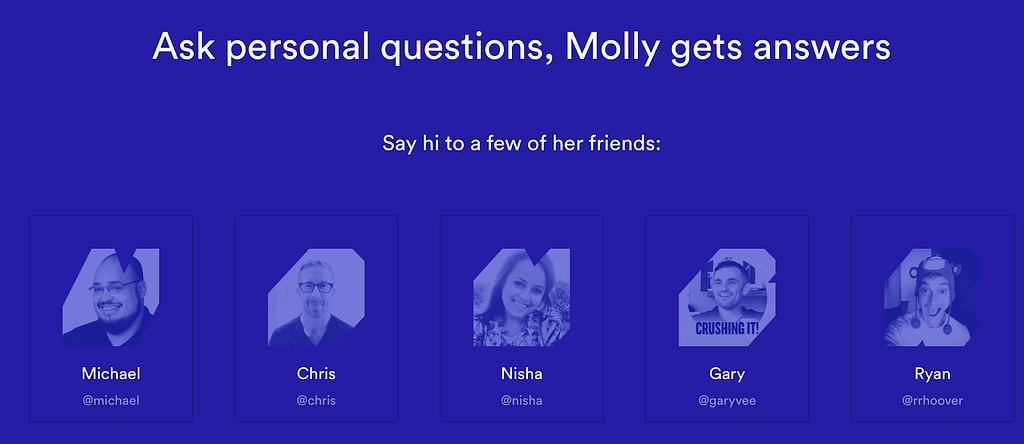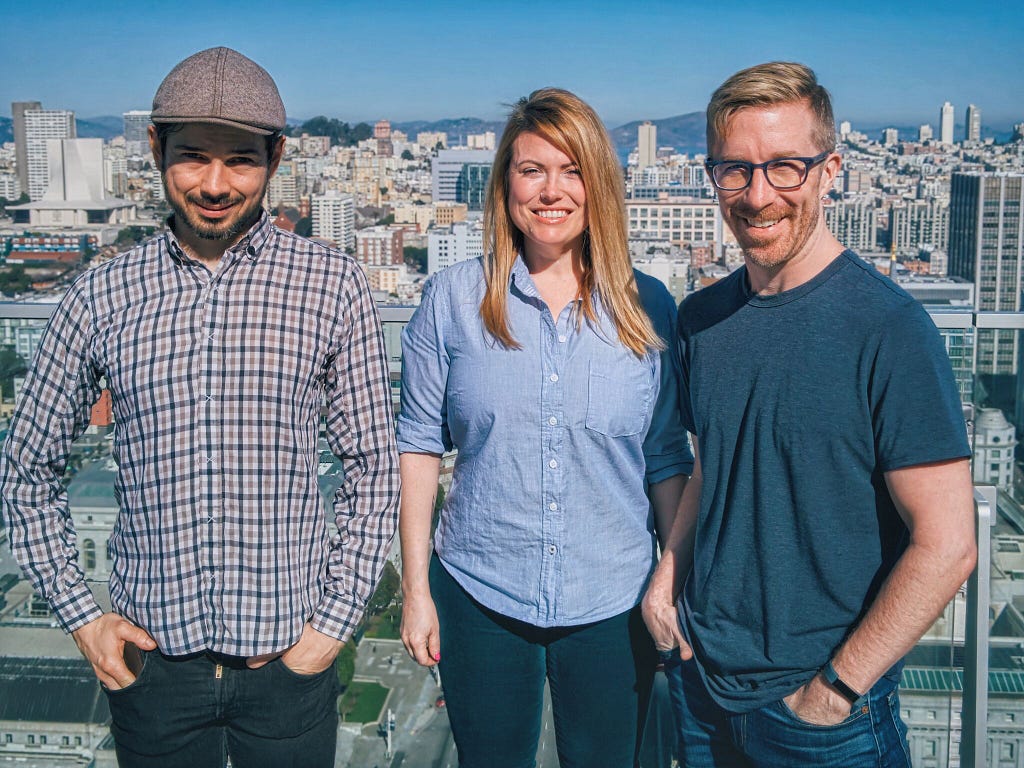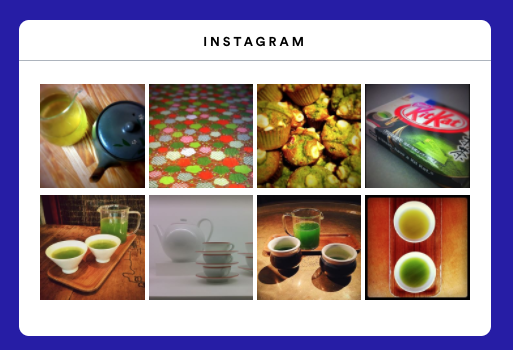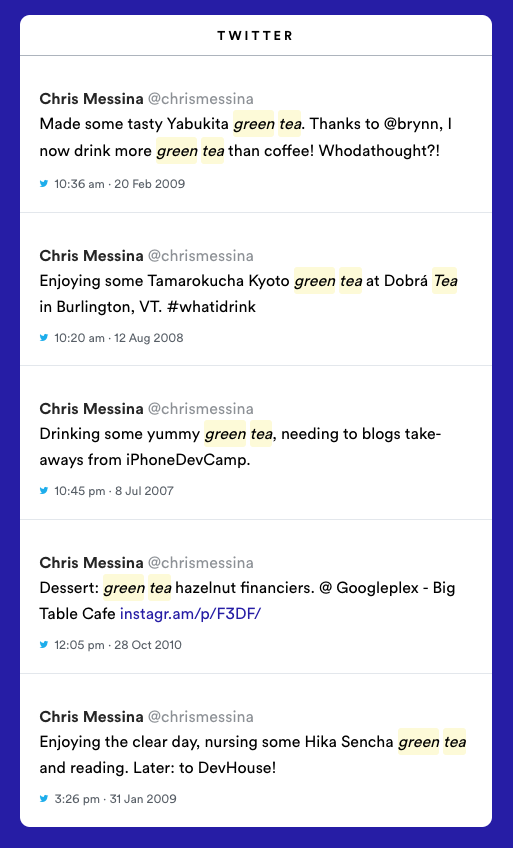Latest news about Bitcoin and all cryptocurrencies. Your daily crypto news habit.
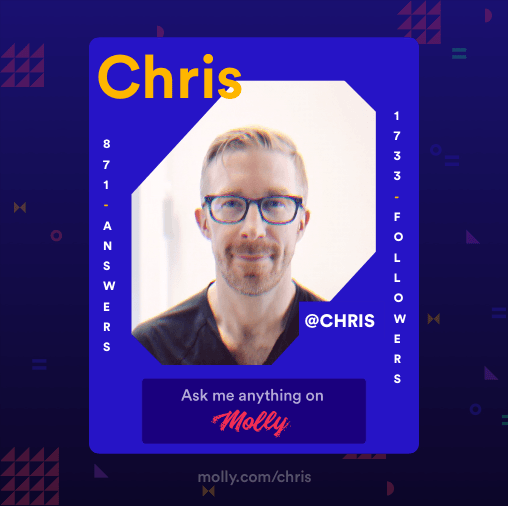
Please welcome Chris Messina to Hacker Noon! Chris is internet famous for inventing the hashtag, and his new company, Molly.com, is more than MDMA’s namesake. It was great to learn more about how he sees the internet and why he does the work he does. I hope you enjoy, and if you have another question for Chris, you can ask him on Molly :-)
David: Molly’s been described as a “automated, 24–7 AMA service.” How much of the product/service is aggregating content you put out on the internet versus actually writing new content about the content you put out on the internet?
Chris: Molly is still in her early infancy, and we want to provide a service that is straightforward and useful before we get too fancy by generating answers on behalf of people. To begin, we want to make it easy and enjoyable for Molly users to ask and answer questions directly, in their own words. At the same time, we believe that many answers to the questions that people have are already public and available on the social web, but are hard to find or are inconveniently spread across a number of platforms. Therefore, we encourage our users to connect to third party platforms like Medium, Twitter, Instagram, and others — so that we can automatically pull up content that Molly thinks might be related, or might help provide more context.
We have a long way to go to improve the relevance of some of these supporting results, but already we’re seeing thematic connections emerge across what were previously disconnected media sources… for example, a lot of people want to know about how Ryan Hoover built Product Hunt’s vibrant community, and in his answer on Molly, we automatically surface YouTube videos and podcasts he’s produced that allow the viewer to go much deeper into his thoughts and experience.
Molly has major personal branding implications. Personalities could in theory be interactive and accessible without the person spending the time to communicate… As more AI shapes brand interactions, how will authenticity be maintained?
Authenticity is closely connected with trust, and trust is a measure of consistency, predictability, and evolution across changing circumstances. Authenticity, therefore, is incredibly important in establishing, building, and maintaining human relationships over time. While, yes, we see a world in which AI counterparts like Molly can act and answer questions on behalf of people, they are not substitutes for the real thing as they lack qualities that make humans so interesting and so confounding.
To draw a crude analogy, if the car is a massive evolution in the capabilities of a bicycle (mobility, range, protection from the elements, capacity, etc), an interactive, personalized, and adaptive service like Molly will become a massive evolution over email vacation auto-responders, away messages, or phone answering machines — rather than a replacement for a person. Throughout time, people have always found themselves too busy or unable to get meet all the demands for their attention; Molly is an attempt to give people more focus on the interactions and connections that matter to them by taking care of some of the more rote or tedious requests for information that’s already been shared.
In the answers that Molly generates, the voice of the individual should persist and be maintained. She simply augments the ability of the individual to marshall the efforts and energy they’ve spent in the past to meet the demands of the present.
A first name dotcom! That’s awesome. How much did Molly.com cost? Or if you can’t say the amount, can you share some details from the negotiation process for such a valuable property?
We can’t disclose how much we paid for the domain, but that’s actually the least interesting aspect of the story of how we ended up with molly.com. It turns out that the domain had been owned by one woman since the 90’s — Molly Holzschlag. Molly is one of the first web standards pioneers and has spent her career advocating on behalf of the open web, among other things. I met Molly many many years ago through the web standards community and felt a kinship in our values and ideals about what the web represents as an open and free platform for publishing. We had already come up with the name Molly and so I thought — what the heck?, why not reach out and tell Molly about what we’re up to and see, in the off chance, if she might be interested in helping out?
After we told her our story and the problem that we were interested in addressing, she loved the idea and graciously agreed to let us use the domain for a fair price. Given how personal this story is, and in honor of Molly’s contributions to the web platform itself, we’re proud to be able to share her story and her symbolic contribution to what we’re doing now.
Molly’s homepage has some of the who’s who of personal branding in tech (Michael Seibel, Nisha Dua, Gary Vaynerchuk , Ryan Hoover, etc). Could you share a bit about who’s invested in Molly and who’s building Molly?
Our current investors include Betaworks, BBG Ventures, Crunchfund, Halogen Ventures, Y Combinator and a few strategic angels.
The Molly team is made up of three co-founders and a few remote engineers — definitely a scrappy crew considering we’ve built products on web, iOS, Messenger, SMS, as well as an Alexa skill in the relatively short period we’ve been working on this!
My background is in product design, UX, developer platforms, and building online communities. I spent several years at Google working on their APIs and social platform, and then a year at Uber where I lead developer experience. Esther was one of the first YouTube stars and translated that success into a successful consultancy helping large CPG brands find their online audiences. Later she helped smaller startups find their voice. Ethan has been hacking since he was six and has spent a lot of time working at startups and running machine learning projects related to personality and psychographics.
What’s Molly’s long-term vision?
Molly will be one of the first brands of the conversational computing era. By learning about the kinds of questions people ask each other and how they answer, she will be a resource that people consult when they want to learn about others or recall information that they may have forgotten. She will be one of the first post-feed, post-camera social agent platforms on the internet.
What are Molly’s KPIs and short term goals?
We’re primarily chasing after product-market fit right now — seeking engagement, utility, and helping Molly’s first users answer the questions that their friends and fans have for them. We want to encourage curiosity and learning about people’s experiences and perspectives — in fun, efficient, and creative ways.
In terms of short term goals, let me draw an analogy: if you think back to the era of landlines telephones, one of the inventions that made it easier to stay connected without having to be stuck by the receiver was the answering machine.
Indeed, in the era of AOL Instant Messenger and other chat services, we had the Away Message, and now in iOS there’s the Do Not Disturb and Do Not Disturb While Driving modes.
These are all useful ways to respond to someone that needs or wants your attention when you don’t have any to offer, or would prefer to get back to them later. But they’re also very dumb.
We believe that there’s already a lot of useful information that people often want to know about you that’s already available to them, but it’s just too hard for them to find it easily, quickly, or in a context that they’d think or know to look in. For example, if you wanted to know whether I like green tea or not before you invite me to meet at Samovar, you can ask Molly, and even though I haven’t specifically answered that question before, you can see from the Instagram photos and tweets that Molly found that indeed, I’ve certainly had some good looking green tea before!
I didn’t have to do anything extra for Molly to learn this information — she pulled it out my public archive of photos and tweets that I previously shared.
In the short term, we think that Molly can answer these and many other questions that you otherwise wouldn’t bother to ask, simply because the likelihood of getting a satisfying answer would be too low. The cost of asking these kinds of curiosity-driven questions (or even those that are pragmatic, i.e. about what kind of beverage to meet up for is) is too high, and we’re going to use AI, good product design, and emerging conversational interfaces to help lower those costs so that we can have our personal curiosities satisfied more quickly and easily than before.
Are you concerned or excited about the branding overlap with the other Molly (MDMA)?
We named our company Molly for several reasons:
- In the era of conversational brands, “billboard brand names” like Clorox and Duracell don’t work as well — you don’t really want to talk to them. This is one reason why, I’d wager, that Alexa has such an edge over the Google Assistant — it’s more natural to say out loud “Alexa, what’s the weather today?” than “Ok Google, what’s the weather?” The latter is simply more robotic and forced. “Molly”, meanwhile, is clearly a name that you’d call someone by. It’s friendly. When it comes to talking to Molly (say, via a voice or messaging interface), it’ll feel… normal.
- Another reason why Molly is a good name for our brand is recall. I install all kinds of apps and have enabled dozens of skills, but remembering the name of each one is incredibly challenging. We think that using a name like Molly makes it easier to remember her.
- The connection to MDMA isn’t lost on us, and the connection is also not unintentional. But while many people only think of MDMA as party drug, we’re thrilled that MDMA was recognized as a “breakthrough therapy” for posttraumatic stress disorder (PTSD) last year. This year we’re going to see the first FDA-approved Phase III trials of MDMA to treat patients with severe PTSD, and presuming they’re successful, will help to lessen the stigma associated with this substance. The effects of MDMA have been well documented and suggest a powerful ability to create deep empathy, connection, and understanding between people — and that’s absolutely an inspiration for the kind of effects we hope our products might create.
How far down the AI writing original content rabbit hole will Molly go?
We imagine a time when Molly will be able to synthesize answers on behalf of people, but that day is not today.
We are already experimenting internally with different approaches to answer generation based on recent machine learning techniques, but the state of the art is still immature and prone to error, due to the complex nature in how humans form questions.
A step towards what you’re suggesting is Molly suggesting relevant media or content that you’ve shared with her and she helps you to assemble an answer. For example, if someone asks you what your favorite book of 2017 was, Molly could show you all the books you’ve read to help you remember. Down the road, we’ll be able to highlight snippets of content that you’ve previously written or shared that might also answer the question — offering a kind of beefed up, personalized autosuggest tool. There’s already a tool in our alpha iOS app called “Ask Molly” that attempts to offer content to you to help you answer questions that you receive — but it’s rather limited so far.
In these early days, we’re spending a lot of effort figuring out how to consume content that people have published online and making sense of it, so we can repurpose it to answer questions automatically. As we get better at understanding the kinds of questions people ask and what typical responses look like, we’ll be able to automate more. For the near term, though, it’s going to be important to keep a human (you!) in the loop until we start composing original answers on your behalf, in your voice.
You invented the hashtag, launch tons of product, helped scale Mozilla, headed key roles at Goole & Uber and now you’re founding another tech company — where do you find the time? Can you walk us through what tasks you did over the last week in your work life?
It’s funny — day to day I feel pretty easily distractible and not that productive (just ask my colleagues, and they’ll confirm this!). That said, when I get into something, I really get in to it, and I tend to become the thing that I’m pursuing. I’ll give you a high level sense for a typical week — which admittedly is somewhat unusual because we’re at the tail end of Y Combinator’s Winter ’18 batch:
- Hunted half a dozen new products (including a few YC batchmates!)
- Got some great coverage on Molly by Molly over at The Ringer
- Invited 1000 people to the brand new Molly community on Discord
- Tweaked the design of our answer cards
- Designed our Twitter answer embeds (example)
- Designed and produced a bunch of animated Twitter promo cards (example)
- Attended an afternoon + evening YC event
- Attended a book launch lunch event with Chris Hughes (co-founder of Facebook)
- Attended a Designer Fund/YC design workshop
- Tweeted a bunch
- Otherwise did a bunch of outreach to a lot of the first Molly users — gathering feedback, tracking down and filing bugs, backfilling content (interviews, AMAs, etc) and otherwise making small design and UI improvements
I’m sure there was more — but that covers some of the highlights!
AI in text based communication is growing like crazy. I think it’s about to blow up customer service. In the future (say 5 or so years), what percentage of text based customer service/support do you think will be powered by AI?
I don’t know if that’s exactly the right way to frame that question, although I agree with your general assertion. A better way is to ask: what experiences are humans really good at creating that machines aren’t, and which jobs can machines be trained to do better? My hope (though we’ll see how it plays out) is that humans and machines can become better collaborators, focusing on what each does uniquely well. In that light, 100% of customer service and support can be assisted by AI in the future, but that doesn’t mean that 0% of those tasks will be handled by humans.
In fact, I think there’s an entirely new domain that will emerge in this space that I call “relationship design”, and it goes beyond just mapping the customer journey and addressing pain points… it really requires an entirely new way to envision the relationships that people have with brands — as extensions and augmentations of themselves. AI will absolutely be part of that trend, but so will human curated experiences, insights, and creative innovations.
It’s wild that you changed the dictionary. “Inventor of the Hashtag.” If you could invent another word internet function and have others adopt it, what would it be and why?
Ha! Well… I tried! In 2009, two years after I proposed the hashtag, I proposed another convention call the “slashtag”. The idea was simple enough: “separate the meta from the meat” — i.e. add helpful information about your content to the end of your tweet, to make it easier to read and connect with people. A few friends use them, but they never really took off. Still, to this day, you see people really scatter hashtags all over their content, especially on Instagram, and it just makes it harder to read what could otherwise be simple and straightforward text. So — I think it’d be cool if more people adopted the behavior, but it’s not quite a widespread or painful enough problem to really catch on.
Also, we’re now in the era of visual and aural communication — so things like stickers, GIFs, amoji, voice recordings, and the like are crowding out the written word for some users… in order to influence the semiotics of a generation at this point I think you’d have to focus on multimedia rather than text.
You’ve hunted 1,468 products on Product Hunt. What’s the most common misconception about how to launch products?
It may seem obvious, but it’s really important for makers to engage the Product Hunt community with the story of why a product exists, what problem it’s trying to solve, how it solves it, and why that solution is meaningful or important to the maker. I mean, it should be common knowledge, but people are attracted to and compelled by stories they can relate to more than they are by ideas alone. The more that your product fits into a known, familiar, or relatable narrative — the more like I think you’ve got a chance to perform well when you’re hunted.
If you could change anything about how the internet functions today, what would it be?
This may sound funny — but I kind of wish that people had to look at a mirror when they published online. Like, there’s research that shows that putting mirrors in department stores deters shoplifting because it causes people to think twice about their actions because suddenly they’re confronted with an image of themselves that they don’t like. The internet has become a pretty hostile environment — and it makes it hard to have meaningful and useful conversations that reveal commonality and connection. Rather than starting with trying to merely improve the connection between people, I think if we improved and strengthened the connection that people have with themselves and their behavior, some of what made the early social web so great and fulfilling might be restored.
Learn more at Molly.com & ask Chris your own question at Molly.com/Chris.
How Chris Messina Works, and What’s the Future of AMAs? was originally published in Hacker Noon on Medium, where people are continuing the conversation by highlighting and responding to this story.
Disclaimer
The views and opinions expressed in this article are solely those of the authors and do not reflect the views of Bitcoin Insider. Every investment and trading move involves risk - this is especially true for cryptocurrencies given their volatility. We strongly advise our readers to conduct their own research when making a decision.
